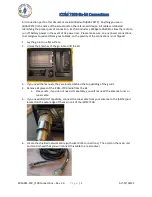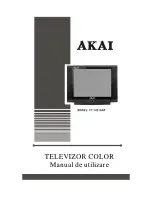
●
Verwenden Sie zum Reinigen nur ein trockenes,
weiches Tuch, niemals Chemikalien oder Wasser.
●
Wird der Empfänger oder das Netzgerät zweck-
entfremdet, nicht richtig angeschlossen, falsch
bedient oder nicht fachgerecht repariert, kann
keine Haftung für daraus resultierende Sach- oder
Personenschäden und keine Garantie für das
Gerät übernommen werden.
●
Sollen der Empfänger und das Netzgerät endgül-
tig aus dem Betrieb genommen werden, überge-
ben Sie die Geräte zur umweltgerechten Entsor-
gung einem örtlichen Recyclingbetrieb.
3
Einsatzmöglichkeiten
Der 2-Kanal-Empfänger TXS-890 bildet in Verbin-
dung mit zwei Sendern der TXS-890-Serie von „img
Stage Line“ ein drahtloses Audio-Übertragungssys-
tem, das speziell für Musiker und den Live-Einsatz
auf der Bühne geeignet ist. Durch die drahtlose Über-
tragung von Musik oder Sprache zur Audioanlage
behält der Musiker während des Auftritts seine Be-
wegungsfreiheit. Die Übertragungsreichweite hängt
von den örtlichen Gegebenheiten ab und kann bis zu
100 m betragen. Für die Audio-Übertragung stehen
16 frei wählbare Kanäle im UHF-Frequenzbereich
790 – 814 MHz zur Verfügung.
Beide Empfangskanäle arbeiten mit „True-Diver-
sity“-Technik: Das Sendesignal wird von zwei räum-
lich getrennten Antennen empfangen und für jeden
Kanal in zwei Empfangsteilen getrennt weiterverar-
beitet. Das jeweils bessere Signal der beiden Emp-
fangsteile wird ausgegeben.
3.1 Zulassung
Die Zulassung für den Empfänger TXS-890 ist nach
der R + TTE-Richtlinie (Radio and Telecommuni-
cation Technical Equipment) in den Staaten der
Europäischen Union gültig. Die EG-Konformitäts-
erklärung finden Sie auf Seite 12. Für den Betrieb in
Staaten außerhalb der EU fragen Sie bitte Ihren
Fachhändler oder die MONACOR-Niederlassung
des entsprechenden Landes.
Hinweis: In Deutschland muss für den Betrieb
des Funksystems eine kostenpflichtige Frequenz-
zuteilung beantragt werden (Informationen dazu
und ein Antragsformular liegen jedem Sender bei).
In anderen Ländern muss eventuell eine entspre-
chende Genehmigung beantragt werden. Informie-
ren Sie sich vor der Inbetriebnahme des Systems
außerhalb Deutschlands bitte bei der MONACOR-
Niederlassung oder der entsprechenden Behörde
des Landes.
4
Rackmontage
Der 2-Kanal-Empfänger ist als Tischgerät oder für
den Einbau in ein Rack für Geräte mit einer Breite
von 482 mm (19") vorgesehen. Für den Rackeinbau
die vier Standfüße abschrauben und die beiden bei-
liegenden Montagewinkel mit jeweils zwei Schrau-
ben vorne an der linken und rechten Seite des
Gehäuses anschrauben.
5
Anschluss
1) Die beiliegenden Antennen (4) in die BNC-Buch-
sen „ANT. 1“ und „ANT 2“ (10) stecken und senk-
recht stellen.
2) Zum Anschluss an das nachfolgende Gerät (z. B.
Mischpult, Verstärker) können die folgenden Au-
dioausgänge verwendet werden:
sym. XLR-Ausgänge „CH.1“ und „CH.2“ (11) für
die Ausgangssignale der einzelnen Empfangs-
kanäle, zum Anschluss an je einen symmetri-
schen Mikrofoneingang
asym. 6,3-mm-Klinkenbuchse „MIXED OUT“ (8),
für das Summensignal der beiden Empfangs-
kanäle, zum Anschluss an einen hoch emp-
findlichen Line-Eingang (ein passendes An-
schlusskabel liegt bei)
3) Das beiliegende Netzgerät mit der Buchse (9) für
die Stromversorgung (12 V
/500 mA) verbinden
und den Netzstecker des Netzgeräts in eine
Steckdose (230 V~ /50 Hz) stecken.
6
Bedienung
Den Empfänger mit der Taste „POWER“ (3) ein-
schalten. Im Display (7) zeigen die Kanalanzeigen (f)
die für beide Empfangseinheiten eingestellten Über-
tragungskanäle. Solange eine Empfangseinheit kein
ausreichend starkes Funksignal empfängt, ist sie
stumm geschaltet [Stummschaltungssymbol (g) ein-
geblendet].
Die weiteren Einstellungen für jede Empfangseinheit
getrennt durchführen. Die folgenden Bedienschritte
beziehen sich auf die Empfangseinheit 1 („CHAN-
NEL 1“).
1) Den Sender einschalten.
Zeigt die Kanalanzeige (f) einen anderen Ka-
nal als am Sender eingestellt, die Empfangs-
einheit auf den Kanal des Senders einstellen –
siehe dazu Kap. 6.1.
Bei gleich eingestelltem Übertragungskanal
an Sender und Empfangseinheit und ausrei-
chend starkem Empfang des Funksignals ist die
Stummschaltung deaktiviert [Stummschaltungs-
symbol (g) erlischt]. Eine der Anzeigen
oder
(e) leuchtet und signalisiert damit, welches der
beiden getrennten Empfangsteile das stärkere
Funksignal empfängt. Die Anzeige „RF“ (c) gibt
die Empfangsqualität wieder: je mehr Segmente
angezeigt werden, desto besser ist der Empfang.
Bei schlechtem oder gestörtem Empfang, über-
prüfen ob:
a auf einem anderen Übertragungskanal der
Empfang besser ist.
b die Batterien des Senders nicht mehr ausrei-
chend geladen sind (siehe Batteriestatus-An-
zeige am Sender).
c der Abstand zwischen Sender und Empfänger
zu groß ist.
d der Empfang durch Gegenstände in der Über-
tragungsstrecke gestört ist.
e sich der Empfang durch Schwenken der An-
tennen verbessern lässt.
f
die Rauschsperre mit dem Squelch-Regler (12)
zu hoch eingestellt ist (siehe Bedienschritt 4).
B
A
5
GB
D
A
CH
●
For cleaning only use a dry, soft cloth; never use
chemicals or water.
●
No guarantee claims for the unit or liability for any
resulting personal damage or material damage
will be accepted if the receiver or the power supply
unit is used for other purposes than originally
intended, if it is not correctly connected, operated
or not repaired in an expert way.
●
If the receiver and the power supply unit are to be
put out of operation definitively, take them to a
local recycling plant for a disposal which is not
harmful to the environment.
●
Important for U. K. Customers!
The wires in the mains lead of the power supply unit
are coloured in accordance with the following code:
blue = neutral; brown = live
As the colours of the wires in the mains lead of this
appliance may not correspond with the coloured
markings identifying the terminals in your plug,
proceed as follows:
1. The wire which is coloured blue must be con-
nected to the terminal in the plug which is
marked with the letter N or coloured black.
2. The wire which is coloured brown must be con-
nected to the terminal which is marked with the
letter L or coloured red.
3
Applications
In combination with two transmitters of the TXS-890
series by “img Stage Line”, the 2-channel multifre-
quency receiver TXS-890 makes up a wireless audio
transmission system which is ideally suited for musi-
cians and live performance on stage. The wireless
transmission of music or speech to the audio system
ensures the musician’s freedom of movement during
the performance. The transmission range largely
depends on the local conditions; a maximum range
of 100 m may be reached. For audio transmission,
16 channels are available, to be freely selected in
the UHF frequency range of 790 – 814 MHz.
Both reception channels operate in true diversity
technique: The transmission signal is received by two
antennas placed at a distance from each other and
separately processed for each channel in two re-
ceiving parts. The more powerful signal respectively
of the two receiving parts is then sent to the output.
3.1 Approval
According to the R + TTE directive (Radio and Tele-
communication Technical Equipment), the approval
for the receiver TXS-890 is valid in the countries of
the European Union. The EC declaration of conform-
ity can be found on page 13. For operation in coun-
tries outside the EU, please contact your retailer or
the MONACOR subsidiary in the particular country.
Note: In Germany, it is necessary to apply for a
frequency assignment of the transmission system
which will be subject to charges. In other countries,
it may be necessary to apply for a corresponding
approval. Prior to operation of the system outside
Germany, please contact the MONACOR subsidiary
or the respective authorities of the country.
4
Rack Installation
The 2-channel receiver is provided for use as a table
top unit or for installation into a rack for units of a
width of 482 mm (19"). For rack installation, unscrew
the four feet, then screw the two supplied mounting
brackets with two screws each to the front at the left
and right sides of the housing.
5
Connection
1) Insert the two supplied antennas (4) into the BNC
jacks “ANT. 1” and “ANT. 2” (10) and put them in
a vertical position.
2) For connecting the subsequent unit (e. g. mixer,
amplifier), the following audio outputs can be used:
bal. XLR outputs “CH.1” and “CH.2” (11) for the
output signals of the individual reception
channels, for connection to one balanced
microphone input each
unbal. 6.3 mm jack “MIXED OUT” (8) for the mas-
ter signal of the two reception channels, for
connection to a highly sensitive line input (a
matching connection cable is supplied)
3) Connect the supplied power supply unit to the
jack (9) for power supply (12 V
/500 mA) and
connect the mains plug of the power supply unit
to a mains socket (230 V~/50 Hz).
6
Operation
Switch on the receiver with the switch “POWER” (3).
The display (7) shows the channel indications (f) of
the transmission channels adjusted for the two
receiving units. As long as a receiving unit does not
receive a radio signal of sufficient power, it is muted
[muting symbol (g) is displayed].
Make the other adjustments separately for each
receiving unit. The following operating steps refer to
the receiving unit 1 (“CHANNEL 1”).
1) Switch on the transmitter.
If the channel indication (f) displays a different
channel than the one adjusted on the transmitter,
adjust the receiving unit to the channel of the
transmitter – see chapter 6.1.
If the transmitter and the receiving unit have
been adjusted to the same transmission channel
and the reception of the radio signal is of suffi-
cient power, the muting is deactivated [muting
symbol (g) disappears]. One of the indications
or
(e) lights up to indicate which of the two
separate receiving parts receives the more
powerful radio signal. The bar graph “RF” (c) indi-
cates the reception quality: the more segments
are displayed, the better is the reception.
With a poor or disturbed reception, check if
a the reception can be improved by using a dif-
ferent transmission channel.
b the batteries of the transmitter are not suffi-
ciently charged any more (see battery status
indication on the transmitter).
c the distance between the transmitter and the
receiver is too long.
B
A
Summary of Contents for 24.3600
Page 9: ...13...





























